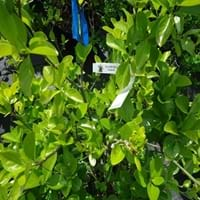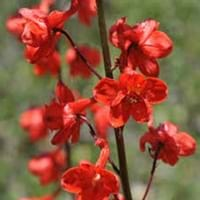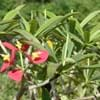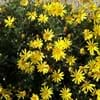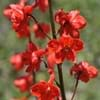Life Span
Perennial
Perennial
Type
Shrub
Flowering Plants, Ornamental Plants, Shrubs
Origin
Europe, Western Asia
Africa
Types
Not Available
Not Available
Number of Varieties
Not Available
Habitat
Floodplains, Open Forest
gardens, meadows
USDA Hardiness Zone
4-7
Not Available
Sunset Zone
1a, 1b, 2a, 2b, 3a, 3b, 4, 5, 6, 7, 8, 9, 14, 15, 16
Not Available
Habit
Oval or Rounded
Upright/Erect
Minimum Width
Not Available
Flower Color
Yellow green
Red, Rose
Flower Color Modifier
Not Available
Bicolor
Fruit Color
Orange
Not Available
Leaf Color in Spring
Green
Green
Leaf Color in Summer
Green
Light Green
Leaf Color in Fall
Yellow, Red, Yellow green
Green, Yellow green
Leaf Color in Winter
Not Available
Green, Light Yellow, Tan
Leaf Shape
Ovate
Palmate and toothed
Plant Season
Fall
Spring, Summer, Fall, Winter
Sunlight
Full Sun, Partial Sun, Partial shade
Full Sun, Partial Sun
Type of Soil
Clay, Loam, Sand
Clay, Loam, Sand
The pH of Soil
Acidic, Neutral, Alkaline
Acidic, Neutral, Alkaline
Soil Drainage
Well drained
Well drained
Bloom Time
Late Spring
Not Available
Tolerances
Drought
Heat And Humidity
Where to Plant?
Ground
Ground, Pot
How to Plant?
Seedlings, Transplanting
Seedlings, Stem Cutting
Plant Maintenance
Medium
Medium
Watering Requirements
Keep the ground moist but not water-logged, Requires a lot of watering, Requires regular watering, Requires watering in the growing season
It cannot sustain wet-feet, Keep ground moist, Requires regular watering, Water more in summer
In Summer
Lots of watering
Lots of watering
In Spring
Moderate
Moderate
In Winter
Average Water
Average Water
Soil pH
Acidic, Neutral, Alkaline
Acidic, Neutral, Alkaline
Soil Type
Clay, Loam, Sand
Clay, Loam, Sand
Soil Drainage Capacity
Well drained
Well drained
Sun Exposure
Full Sun, Partial Sun, Partial shade
Full Sun, Partial Sun
Pruning
Prune in late winter, Prune in spring, Remove dead leaves, Remove shoots
Cut away fading foliage, Do not prune during shooting season, Remove damaged leaves, Remove deadheads
Fertilizers
All-Purpose Liquid Fertilizer
High-phosphorous fertilizers used, Organic Flower Fertilizer
Pests and Diseases
Red blotch
Bacterial leaf spot, fungus, Mealybugs
Plant Tolerance
Drought
Heat And Humidity
Flowers
Insignificant
Yes
Flower Petal Number
Single
Single
Foliage Texture
Medium
Fine
Foliage Sheen
Glossy
Matte
Attracts
Birds
Butterflies
Allergy
Asthma
Severe allergen, Skin irritation, Skin rash, Throat itching, Vomiting
Aesthetic Uses
Beautification, Landscape Designing, Showy Purposes
Beautification, Borders, Showy Purposes, Used for decorating walls, fences, gates, hedges, etc.
Beauty Benefits
Not Available
Not Available
Environmental Uses
Air purification
Air purification
Medicinal Uses
Not Available
Not Available
Part of Plant Used
Fruits, Seeds
Flowers
Other Uses
Decoration Purposes, Showy Purposes, Used as Ornamental plant
Used in making blue ink
Used As Indoor Plant
No
No
Used As Outdoor Plant
Yes
Yes
Garden Design
Hedges, Screening, Wind Break
Edging, Feature Plant
Botanical Name
EUONYMUS europaeus
Delphinium cardinale
Common Name
European spindle
Scarlet larkspur, Cardinal larkspur
In Hindi
आम धुरी
लाल रंग Delphinium
In German
gemeinsamen Spindel
Scarlet Delphinium
In French
axe commun
Scarlet Delphinium
In Spanish
husillo Común
Scarlet Delphinium
In Greek
κοινή άξονα
Scarlet Δελφίνιο
In Portuguese
eixo comum
Scarlet Delphinium
In Polish
wspólna wrzeciona
Scarlet Delphinium
In Latin
commune fusum
Delphinium coccino
Phylum
Tracheobionta
Tracheophyta
Class
Magnoliopsida
Magnoliopsida
Order
Celastrales
Ranunculales
Family
Celastraceae
Ranunculaceae
Genus
Euonymus
Delphinium
Clade
Angiosperms, Eudicots, Rosids
Angiosperms, Eudicots
Tribe
Not Available
Not Available
Subfamily
Not Applicable
Not Available
Number of Species
Not Available
Importance of Common Spindle and Scarlet Delphinium
Want to have the most appropriate plant for your garden? You might want to know the importance of Common Spindle and Scarlet Delphinium. Basically, these two plants vary in many aspects. Compare Common Spindle and Scarlet Delphinium as they differ in many characteristics such as their life, care, benefits, facts, etc. Every gardener must at least have the slightest clue about the plants he wants to plant in his garden. Compare their benefits, which differ in many ways like facts and uses. The medicinal use of Common Spindle is Not Available whereas of Scarlet Delphinium is Not Available. Common Spindle has beauty benefits as follows: Not Available while Scarlet Delphinium has beauty benefits as follows: Not Available.
Compare Facts of Common Spindle vs Scarlet Delphinium
How to choose the best garden plant for your garden depending upon its facts? Here garden plant comparison will help you to solve this query. Compare the facts of Common Spindle vs Scarlet Delphinium and know which one to choose. As garden plants have benefits and other uses, allergy is also a major drawback of plants for some people. Allergic reactions of Common Spindle are Asthma whereas of Scarlet Delphinium have Severe allergen, Skin irritation, Skin rash, Throat itching and Vomiting respectively. Having a fruit bearing plant in your garden can be a plus point of your garden. Common Spindle has showy fruits and Scarlet Delphinium has no showy fruits. Also Common Spindle is not flowering and Scarlet Delphinium is flowering. You can compare Common Spindle and Scarlet Delphinium facts and facts of other plants too.
